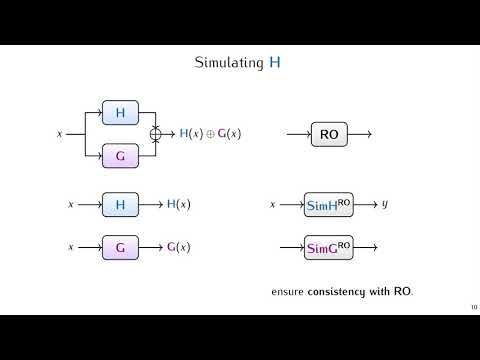CryptoDB
Towards Defeating Backdoored Random Oracles: Indifferentiability with Bounded Adaptivity
| Authors: | |
|---|---|
| Download: | |
| Abstract: | In the backdoored random-oracle (BRO) model, besides access to a random function $\hash$, adversaries are provided with a backdoor oracle that can compute arbitrary leakage functions $f$ of the function table of $\hash$. Thus, an adversary would be able to invert points, find collisions, test for membership in certain sets, and more. This model was introduced in the work of Bauer, Farshim, and Mazaheri (Crypto 2018) and extends the auxiliary-input idealized models of Unruh (Crypto 2007), Dodis, Guo, and Katz (Eurocrypt 2017), Coretti et al. (Eurocrypt 2018), and Coretti, Dodis, and Guo (Crypto~2018). It was shown that certain security properties, such as one-wayness, pseudorandomness, and collision resistance can be re-established by combining two independent BROs, even if the adversary has access to both backdoor oracles. In this work we further develop the technique of combining two or more independent BROs to render their backdoors useless in a more general sense. More precisely, we study the question of building an \emph{indifferentiable} and backdoor-free random function by combining multiple BROs. Achieving full indifferentiability in this model seems very challenging at the moment. We however make progress by showing that the xor combiner goes well beyond security against preprocessing attacks and offers indifferentiability as long as the adaptivity of queries to different backdoor oracles remains logarithmic in the input size of the BROs. We even show that an extractor-based combiner of three BROs can achieve indifferentiability with respect to a linear adaptivity of backdoor queries. Furthermore, a natural restriction of our definition gives rise to a notion of \emph{indifferentiability with auxiliary input}, for which we give two positive feasibility results. To prove these results we build on and refine techniques by Göös et al. (STOC 2015) and Kothari et al. (STOC 2017) for decomposing distributions with high entropy into distributions with more structure and show how they can be applied in the more involved adaptive settings. |
Video from TCC 2020
BibTeX
@article{tcc-2020-30600,
title={Towards Defeating Backdoored Random Oracles: Indifferentiability with Bounded Adaptivity},
booktitle={Theory of Cryptography},
publisher={Springer},
author={Yevgeniy Dodis and Pooya Farshim and Sogol Mazaheri and Stefano Tessaro},
year=2020
}

